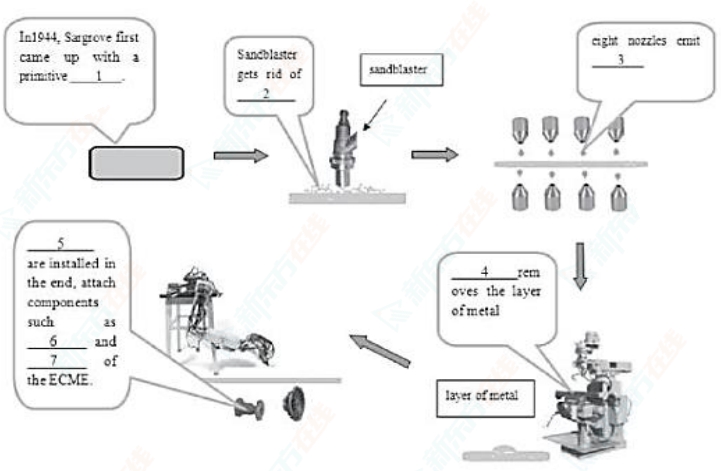

雅思备考规划
扫码添加助教免费咨询雅思备考规划

扫码下载 新东方雅思Pro APP,雅思备考一站式工具
本文为大家带来的是雅思阅读模拟题:Radio Automation,帮助大家备考雅思.
点击查看》》》雅思阅读模拟题汇总【备考必刷】
Today they are everywhere. Production lines are controlled by computers and operated by robots. There’s no chatter of assembly workers, just the whirr and click of machines. In the mid-1940s, the workerless factory was still the stuff of science fiction. There were no computers to speak of and electronics were primitive. Yet hidden away in the English countryside was a highly automated production line called ECME, which could turn out 1500 radio receivers a day with almost no help from human hands.
A John Sargrove, the visionary engineer who developed the technology, was way ahead of his time. For more than a decade, Sargrove had been trying to figure out how to make cheaper radios. Automating the manufacturing process would help. But radios didn’t lend themselves to such methods: there were too many parts to fit together and too many wires to solder. Even a simple receiver might have 30 separate components and 80 handsoldered connections. At every stage, things had to be tested and inspected. Making radios required highly skilled labour— and lots of it.
B In 1944, Sargrove came up with the answer. His solution was to dispense with most of the fiddly bits by inventing a primitive chip—a slab of Bakelite with all the receiver’s electrical components and connections embedded in it. This was something that could be made by machines, and he designed those too. At the end of the war, Sargrove built an automatic production line, which he called ECME (electronic circuit-making equipment), in a small factory in Effingham, Surrey.
C An operator sat at one end of each ECME line, feeding in die plates. She didn’t need much skill, only quick hands. From now on, everything was controlled by electronic switches and relays. First stop was the sandblaster, which roughened the surface of the plastic so that molten metal would stick to it. The plates were then cleaned to remove any traces of grit The machine automatically checked that the surface was rough enough before sending the plate to the spraying section. There, eight nozzles rotated into position and sprayed molten zinc over both sides of the plate. Again, the nozzles only began to spray when a plate was in place. The plate whizzed on. The next stop was the milling machine, which ground away the surface layer of metal to leave the circuit and other components in the grooves and recesses. Now the plate was a composite of metal and plastic. It sped on to be lacquered and have its circuits tested. By the time it emerged from the end of the line, robot hands had fitted it with sockets to attach components such as valves and loudspeakers. When ECME was working flat out; the whole process took 20 seconds.
D ECME was astonishingly advanced. Electronic eyes, and photocells that generated a small current when a panel arrived, triggered each step in the operation, BO avoiding excessive wear and tear on the machinery. The plates were automatically tested at each stage as they moved along the conveyor. And if more than two plates in succession were duds, the machines were automatically adjusted—or if necessary halted In a conventional factory, workers would test faulty circuits and repair them. But Sargrove’s assembly line produced circuits so cheaply they just threw away the faulty ones. Sargrove’s circuit board was even more astonishing for the time. It predated the more familiar printed circuit, with wiring printed on aboard, yet was more sophisticated. Its built-in components made it more like a modem chip.
E When Sargrove unveiled his invention at a meeting of the British Institution of Radio Engineers in February 1947, the assembled engineers were impressed. So was the man from The Times. ECME, he reported the following day, “produces almost without human labour, a complete radio receiving set. This new method of production can be equally well applied to television and other forms of electronic apparatus.
F The receivers had many advantages over their predecessors, with components they were more robust. Robots didn’t make the sorts of mistakes human assembly workers sometimes did. “Wiring mistakes just cannot happen,” wrote Sargrove. Now es also meant the radios were lighter and cheaper to ship abroad. And with no soldered wires to come unstuck, the radios were more reliable. Sargrove pointed out that the circuit boards didn’t have to be flat. They could be curved, opening up the prospect of building the electronics into the cabinet of Bakelite radios.
G Sargrove was all for introducing this type of automation to other products. It could be used to make more complex electronic equipment than radios, he argued. And even if only part of a manufacturing process were automated, the savings would be substantial. But while his invention was brilliant, his timing was bad. ECME was too advanced for its own good. It was only competitive on huge production runs because each new job meant retooling the machines. But disruption was frequent. Sophisticated as it was, ECME still depended on old-fashioned electromechanical relays and valves—which failed with monotonous regularity. The state of Britain’s economy added to Sargrove’s troubles. Production was dogged by power cuts and post-war shortages of materials. Sargrove’s financial backers began to get cold feet.
H There was another problem Sargrove hadn’t foreseen. One of ECME’s biggest advantages—the savings on the cost of labour—also accelerated its downfall. Sargrove’s factory had two ECME production lines to produce the two circuits needed for each radio. Between them these did what a thousand assembly workers would otherwise have done. Human hands were needed only to feed the raw material in at one end and plug the valves into the sockets and fit the loudspeakers at the other. After that, the only job left was to fit the pair of Bakelite panels into a radio cabinet and check that it worked.
I Sargrove saw automation as the way to solve post-war labour shortages. With somewhat Utopian idealism, he imagined his new technology would free people from boring, repetitive jobs on the production line and allow them to do more interesting work. “Don’t get the idea that we are out to rob people of their jobs,” he told the Daily Mirror. “Our task is to liberate men and women from being slaves of machines.”
J The workers saw things differently. They viewed automation in the same light as the everlasting light bulb or the suit that never wears out—as a threat to people’s livelihoods. If automation spread, they wouldn’t be released to do more exciting jobs. They’d be released to join the dole queue. Financial backing for ECME fizzled out. The money dried up. And Britain lost its lead in a technology that would transform industry just a few years later.
Questions 1-7
Summary
The following diagram explains the process of ECME:
Complete the following chart of the paragraphs of Reading Passage, using NO MORE THAN TWO WORDS from the Reading Passage for each answer.
Write your answers in boxes 1-7 on your answer sheet.

1.....................
2.....................
3.....................
4.....................
5.....................
6.....................
7.....................
Questions 8-11
Complete the following summary of the paragraphs of Reading Passage. Using NO MORE THAN TWO WORDS from the Reading Passage for each answer.
Write your answers in boxes 8-11 on your answer sheet
Summary
Sargrove had been dedicated to creating a 8................... radio by automation of manufacture. The old version of radio had a large number of independent 9.................... After this innovation was made, wireless-style radios became 10.................. and inexpensive to export overseas. As the Saigrove saw it, the real benefit of ECME’s radio was that it reduced 11.................. of manual work; which can be easily copied to other industries of manufacturing electronic devices.
Questions 12-13
Choose the correct letter A, B, C or D.
Write your answers in boxes 12-13 on your answer sheet
12 What were workers' attitudes towards ECME Model initially
A anxious
B welcoming
C boring
D inspiring
13 What is the main idea of this passage?
A approach to reduce the price of radio
B a new generation of fully popular products and successful business
C in application of die automation in the early stage
D ECME technology can be applied in many product fields
Answer keys
1. chip
2. grit
3. molten zinc
4. milling machine
5. sockets
6. loudspeakers
7. valves
8. cheaper
9. components
10. lighter
11. cost
12.A
13.D
【雅思免费试听课-0元领取】
【雅思水平测试-免费】
【雅思备考资料-扫码添加助教免费领取】


 资料下载
资料下载
雅思写作高频词汇PDF下载
发布时间:2023-08-26添加新东方在线雅思助教号
回复【200】获取
590组雅思阅读写作必背短语PDF版下载
发布时间:2023-08-09添加新东方在线雅思助教号
回复【590】获取
雅思学术词汇搭配表PDF版下载
发布时间:2023-08-04添加新东方在线雅思助教号
回复【ACL】获取
雅思口语part3结构策略PDF版下载
发布时间:2023-08-04添加新东方在线雅思助教号
回复【Part3】获取
雅思听力高频场景词PDF版下载
发布时间:2023-08-09添加新东方在线雅思助教号
回复【高频词】获取
雅思口语Part2答案示范15篇PDF下载
发布时间:2023-07-26添加新东方在线雅思助教号
回复【P2】获取
雅思小作文35组必备表达PDF下载
发布时间:2023-07-26添加新东方在线雅思助教号
回复【35】获取
雅思阅读高频短语PDF下载
发布时间:2023-07-20添加新东方在线雅思助教号
回复【短语】获取
200组雅思写作高频词汇PDF下载
发布时间:2023-07-20添加新东方在线雅思助教号
回复【200】获取
雅思写作话题词汇PDF下载
发布时间:2023-07-16添加新东方在线雅思助教号
回复【话题】获取
50组雅思口语同义替换词PDF下载
发布时间:2023-07-10添加新东方在线雅思助教号
回复【替换】获取
雅思写作大作文精选题目101PDF下载
发布时间:2023-07-09添加新东方在线雅思助教号
回复【101】获取
雅思口语核心300词PDF下载
发布时间:2023-06-23添加新东方在线雅思助教号
回复【300】获取
雅思阅读分类词汇PDF下载
发布时间:2023-06-17添加新东方在线雅思助教号
回复【分类词】获取
雅思口语必备习语PDF下载
发布时间:2023-06-17添加新东方在线雅思助教号
回复【习语】获取
雅思小作文常用词汇66词PDF下载
发布时间:2023-06-16添加新东方在线雅思助教号
回复【66】获取
雅思口语常见功能结构109句PDF下载
发布时间:2023-06-08添加新东方在线雅思助教号
回复【109】获取
10年雅思写作题库PDF下载
发布时间:2023-06-08添加新东方在线雅思助教号
回复【写作话题】获取
雅思图表作文精选套句50句PDF下载
发布时间:2023-05-28添加新东方在线雅思助教号
回复【50】获取
雅思写作99组高频词汇PDF资料
发布时间:2023-05-28添加新东方在线雅思助教号
回复【99】获取
2023年5月雅思口语新题题库PDF版本
发布时间:2023-05-14添加新东方在线雅思助教号
回复【新题】获取
2023年5-8月雅思口语新题题库与解析PDF版本
发布时间:2023-05-06关注新东方在线考雅课程中心服务号
回复【新题】获取
雅思听力考点词汇PDF资料
发布时间:2023-04-27添加新东方在线雅思助教号
回复【考点词】获取
雅思听力机经词汇PDF资料
发布时间:2023-04-24添加新东方在线雅思助教号
回复【TL】获取
雅思口语Part1常见话题语料库PDF资料
发布时间:2023-04-20添加新东方在线雅思助教号
回复【Part1】获取
剑桥雅思阅读长难句50句PDF资料
发布时间:2023-04-19添加新东方在线雅思助教号
回复【长难句】获取
雅思阅读核心学术词汇表PDF资料
发布时间:2023-04-07关注新东方在线考雅课程中心服务号
回复【核心】获取
100个雅思写作观点词和替换词表达PDF资料
发布时间:2023-03-24关注新东方在线考雅课程中心服务号
回复【100】获取
雅思阅读分类词汇PDF资料
发布时间:2023-03-22关注新东方在线考雅课程中心服务号
回复【分类词】获取
雅思阅读短语PDF资料
发布时间:2023-03-08关注新东方在线考雅课程中心服务号
回复【短语】获取

添加新东方在线雅思助教,
回复【口语】获取雅思口语资料大礼包

 推荐阅读
推荐阅读
本文为大家带来的是雅思阅读模拟题:What are you laughing at?,帮助大家备考雅思
本文为大家带来的是雅思阅读模拟题:Fishbourne Roman Palace,帮助大家备考雅思
本文为大家带来的是雅思阅读模拟题:London Swaying Footbridge,帮助大家备考雅思
本文为大家带来的是雅思阅读模拟题:Knowledge in medicine,帮助大家备考雅思
本文为大家带来的是雅思阅读模拟题:The beginning of intelligence,帮助大家备考雅思










 资料下载
资料下载
添加新东方在线雅思助教号
回复【单词卡】获取
添加新东方在线雅思助教号
回复【200】获取
添加新东方在线雅思助教号
回复【590】获取
添加新东方在线雅思助教号
回复【ACL】获取
添加新东方在线雅思助教号
回复【Part3】获取
添加新东方在线雅思助教号
回复【高频词】获取
添加新东方在线雅思助教号
回复【P2】获取
添加新东方在线雅思助教号
回复【35】获取
添加新东方在线雅思助教号
回复【短语】获取
添加新东方在线雅思助教号
回复【200】获取
添加新东方在线雅思助教号
回复【话题】获取
添加新东方在线雅思助教号
回复【替换】获取
添加新东方在线雅思助教号
回复【101】获取
添加新东方在线雅思助教号
回复【300】获取
添加新东方在线雅思助教号
回复【分类词】获取
添加新东方在线雅思助教号
回复【习语】获取
添加新东方在线雅思助教号
回复【66】获取
添加新东方在线雅思助教号
回复【109】获取
添加新东方在线雅思助教号
回复【写作话题】获取
添加新东方在线雅思助教号
回复【50】获取
添加新东方在线雅思助教号
回复【99】获取
添加新东方在线雅思助教号
回复【新题】获取
关注新东方在线考雅课程中心服务号
回复【新题】获取
添加新东方在线雅思助教号
回复【考点词】获取
添加新东方在线雅思助教号
回复【TL】获取
添加新东方在线雅思助教号
回复【Part1】获取
添加新东方在线雅思助教号
回复【长难句】获取
关注新东方在线考雅课程中心服务号
回复【核心】获取
关注新东方在线考雅课程中心服务号
回复【100】获取
关注新东方在线考雅课程中心服务号
回复【分类词】获取

 编辑推荐
编辑推荐
 雅思新题
雅思新题
 阅读排行榜
阅读排行榜
 相关内容
相关内容